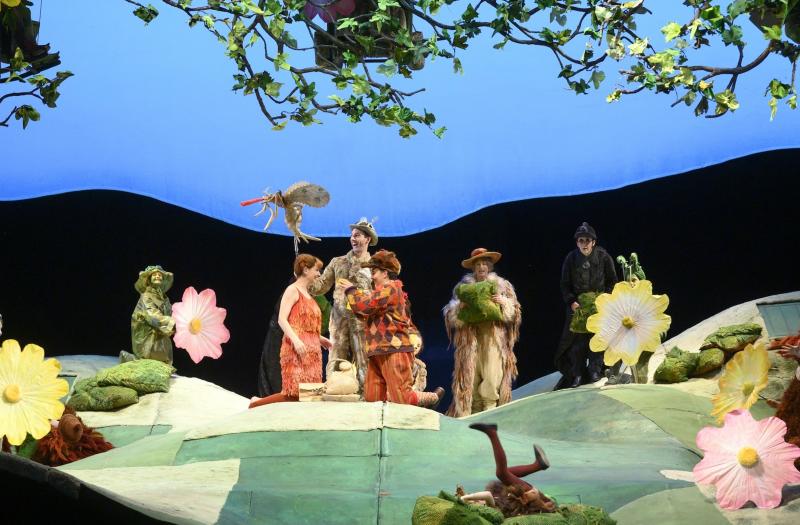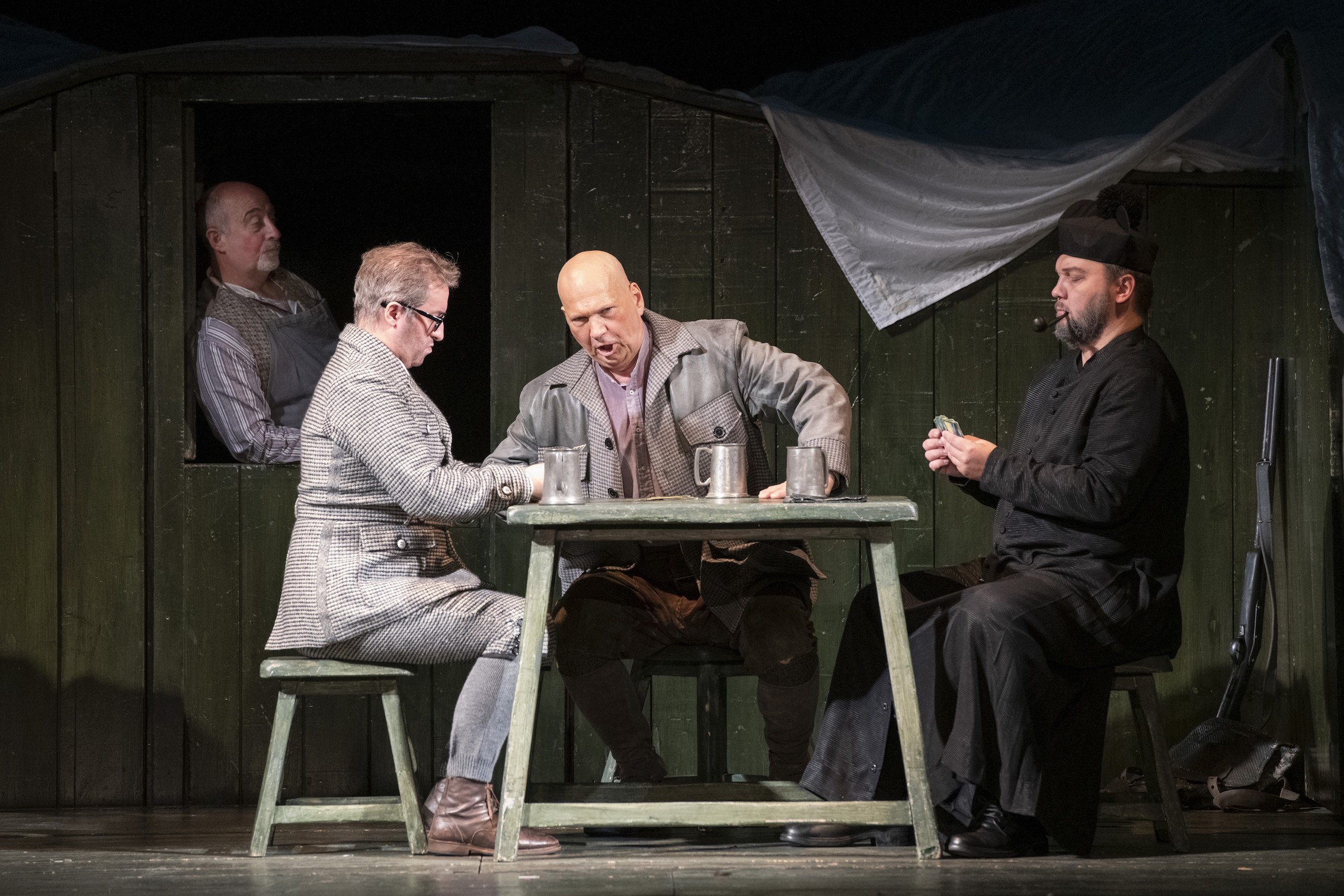The Cunning Little Vixen, Welsh National Opera review - family night in the forest | reviews, news & interviews
The Cunning Little Vixen, Welsh National Opera review - family night in the forest
The Cunning Little Vixen, Welsh National Opera review - family night in the forest
Janáček’s life cycle comes up fresh and inspiring after four decades

Considering that Janáček’s Vixen is, among other things, an allegory of the passing and returning years, it’s appropriate that WNO continue to recycle David Pountney’s now nearly 40-year-old production, and that it comes up each time refreshed, with this or that altered or added detail, but quantum-like the same general image.
Admittedly this isn’t exactly a typical kid’s show, being almost entirely about sex – a problem, I suppose, less for the kids themselves than for the squirming grown-ups next to them, the Internet and Facebook being what they are. Janáček’s subject started life as a strip cartoon in a Prague newspaper, and in its operatic form it retains the snapshot character of the original, a sequence of vignettes in which all the components of the life cycle are brought in without ceremony or the usual narrative build-up. “Have you ever made love?” the Fox enquires of the Vixen five minutes (at most) after they’ve met, and in the flash of a spider’s eye they’ve vanished into her lair, only to emerge another five minutes later with her in that condition where – in nice bourgeois circles – a priest is urgently needed (today it would be a doctor, but let that pass).
And so it goes on. The Forester’s dog tries to roger the Vixen, the cockerel inseminates his hens while the Vixen lectures them about women’s rights. And all the male humans dream about the mythical Terynka, who dances across the stage semi-naked, the embodiment of that spirit of birth and rebirth who they know they will never again hold in their arms. Near the end the Poacher shoots the Vixen. But this is no tragedy. The dragonfly dies in a day and life comes round to the next dragonfly and the next vixen.
Janáček’s late style adapts brilliantly to this lapidary type of narrative, with its montage of brief melodic figures alternating and repeating, often within a static, unchanging harmony. But narrative is perhaps not quite the word. Fragments of story flit across the seasonal canvas, with its swarming array of creatures wild and domestic – insects, birds, foxes, badgers, people.  It’s wonderfully easy on the eye, in the late Maria Bjørnson’s witty anthropomorphic designs, but less easy, I’ve often thought, on the singers, who, apart from the Fox and the Vixen in their one long scene, have little chance to get into their roles in between the dancings and prancings of the fancy-dress animals, enchantingly played here by a whole regiment of the young and not quite so young, and beautifully choreographed by Elaine Tyler-Hall on Stuart Hopps’s original scheme.
It’s wonderfully easy on the eye, in the late Maria Bjørnson’s witty anthropomorphic designs, but less easy, I’ve often thought, on the singers, who, apart from the Fox and the Vixen in their one long scene, have little chance to get into their roles in between the dancings and prancings of the fancy-dress animals, enchantingly played here by a whole regiment of the young and not quite so young, and beautifully choreographed by Elaine Tyler-Hall on Stuart Hopps’s original scheme.
All the same, the singing – in Czech, for the first time here – is both eloquent and stylish. The Northern Irish soprano, Aoife Miskelly, sparkles as the Vixen, as athletic vocally as she is physically, jitterbugging around the stage in authentic twenties fashion. Claudio Otelli is likewise an outstanding Forester (pictured above, centre, with Martin Lloyd, Peter Van Hulle and Wojtek Gierlach), in big, vibrant voice, and giving the impression of having spent his entire life in the woods with a gun in his hand. David Stout repeats his sly portrait of the Poacher Harašta, who does, it seems, marry Terynka, but surely not the same one. Peter Van Hulle is a splendidly bibulous schoolmaster, Lucia Cervoni a smooth, stately soprano fox, the sort you might (unwisely) trust with your chickens.
Too many others to name individually: all excellent. And no praise can be too great for the orchestra, whom Janáček favours with his most exquisite instrumental entomology, captured here with microscopic refinement under the composer’s fellow Moravian, Tomáš Hanus, back on top form after a less than brilliant Carmen.
The future of Arts Journalism
You can stop theartsdesk.com closing!
We urgently need financing to survive. Our fundraising drive has thus far raised £49,000 but we need to reach £100,000 or we will be forced to close. Please contribute here: https://gofund.me/c3f6033d
And if you can forward this information to anyone who might assist, we’d be grateful.

Subscribe to theartsdesk.com
Thank you for continuing to read our work on theartsdesk.com. For unlimited access to every article in its entirety, including our archive of more than 15,000 pieces, we're asking for £5 per month or £40 per year. We feel it's a very good deal, and hope you do too.
To take a subscription now simply click here.
And if you're looking for that extra gift for a friend or family member, why not treat them to a theartsdesk.com gift subscription?
more Opera
 Cinderella/La Cenerentola, English National Opera review - the truth behind the tinsel
Appealing performances cut through hyperactive stagecraft
Cinderella/La Cenerentola, English National Opera review - the truth behind the tinsel
Appealing performances cut through hyperactive stagecraft
 Tosca, Royal Opera review - Ailyn Pérez steps in as the most vivid of divas
Jakub Hrůša’s multicoloured Puccini last night found a soprano to match
Tosca, Royal Opera review - Ailyn Pérez steps in as the most vivid of divas
Jakub Hrůša’s multicoloured Puccini last night found a soprano to match
 Tosca, Welsh National Opera review - a great company reduced to brilliance
The old warhorse made special by the basics
Tosca, Welsh National Opera review - a great company reduced to brilliance
The old warhorse made special by the basics
 BBC Proms: The Marriage of Figaro, Glyndebourne Festival review - merriment and menace
Strong Proms transfer for a robust and affecting show
BBC Proms: The Marriage of Figaro, Glyndebourne Festival review - merriment and menace
Strong Proms transfer for a robust and affecting show
 BBC Proms: Suor Angelica, LSO, Pappano review - earthly passion, heavenly grief
A Sister to remember blesses Puccini's convent tragedy
BBC Proms: Suor Angelica, LSO, Pappano review - earthly passion, heavenly grief
A Sister to remember blesses Puccini's convent tragedy
 Orpheus and Eurydice, Opera Queensland/SCO, Edinburgh International Festival 2025 review - dazzling, but distracting
Eye-popping acrobatics don’t always assist in Gluck’s quest for operatic truth
Orpheus and Eurydice, Opera Queensland/SCO, Edinburgh International Festival 2025 review - dazzling, but distracting
Eye-popping acrobatics don’t always assist in Gluck’s quest for operatic truth
 MARS, Irish National Opera review - silly space oddity with fun stretches
Cast, orchestra and production give Jennifer Walshe’s bold collage their all
MARS, Irish National Opera review - silly space oddity with fun stretches
Cast, orchestra and production give Jennifer Walshe’s bold collage their all
 Káťa Kabanová, Glyndebourne review - emotional concentration in a salle modulable
Janáček superbly done through or in spite of the symbolism
Káťa Kabanová, Glyndebourne review - emotional concentration in a salle modulable
Janáček superbly done through or in spite of the symbolism
 Buxton International Festival 2025 review - a lavish offering of smaller-scale work
Allison Cook stands out in a fascinating integrated double bill of Bernstein and Poulenc
Buxton International Festival 2025 review - a lavish offering of smaller-scale work
Allison Cook stands out in a fascinating integrated double bill of Bernstein and Poulenc
 Tosca, Clonter Opera review - beauty and integrity in miniature
Happy surprises and a convincing interpretation of Puccini for today
Tosca, Clonter Opera review - beauty and integrity in miniature
Happy surprises and a convincing interpretation of Puccini for today
 Hamlet, Buxton International Festival review - how to re-imagine re-imagined Shakespeare
Music comes first in very 19th century, very Romantic, very French operatic creation
Hamlet, Buxton International Festival review - how to re-imagine re-imagined Shakespeare
Music comes first in very 19th century, very Romantic, very French operatic creation
 Falstaff, Glyndebourne review - knockabout and nostalgia in postwar Windsor
A fat knight to remember, and snappy stagecraft, overcome some tedious waits
Falstaff, Glyndebourne review - knockabout and nostalgia in postwar Windsor
A fat knight to remember, and snappy stagecraft, overcome some tedious waits

Add comment